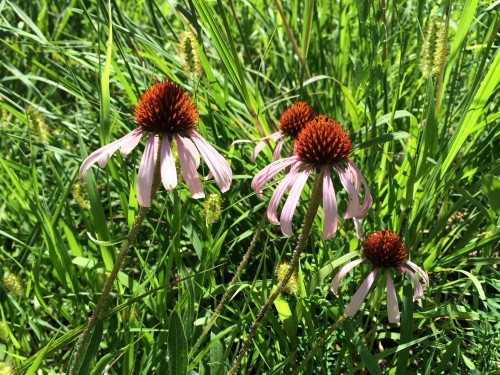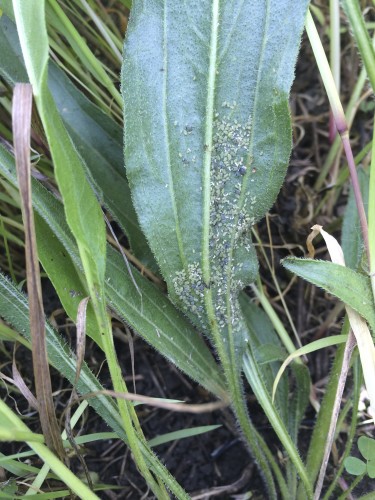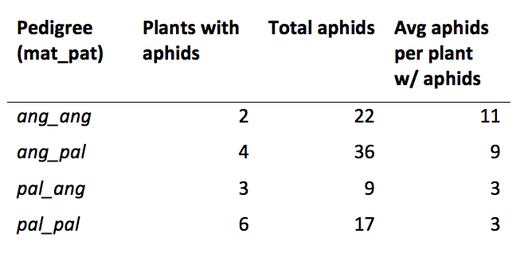|
|
 Some heads in p1 that are just about done flowering. With so many of our remnant Echinacea done flowering (less than 300 down from the 2,000 we visited at peak!), this past Tuesday found the team with some extra time on their hands. Instead of starting out with phenology, we got a chance to make progress on our independent projects. Abby and I headed out to p1 to spend some time with the specialist aphid, Aphis echinaceae. For the past few weeks we’ve been applying addition and exclusion treatments to 100 study plants in the plot with the goal of understanding some of the effects of the aphid on its host plant–continuing a study that Katherine Muller began a few years back.
The wet and dewy Tuesday morning marked our seventh round of treatments. Since starting out we’ve learned a lot about handling (“herding”) our aphids–how best to coax them from their colonies, how to keep them happy during the move between leaves, how to get them settled on their new leaves. Aphid transferring is a delicate process that requires patience and a loving touch. Offering words of comfort and encouragement seems to help ease the transition for the aphids.
While we started out with a pretty scarce supply of aphids in the garden, only able to add a couple of aphids to each of our plants and struggling to get colonies to establish, we’ve noticed a recent spike in the population. After managing to apply about 10 aphids to each plant in one of our recent treatments, we finally had some successes. On Tuesday, we found about half of our additions plants with small colonies taking hold.
 This collection plant had some of the most aphids we’ve seen yet in one place! Some hypothesize that specialist aphids can have a more positive effect on their hosts as compared to generalist aphids. In just a week or two we’ll start assessing our study plants for fitness characteristics like basal leaf count and length of longest leaf, as well as for patterns in herbivory and senescence, to see if years of these addition and exclusion treatments have impacted the plants. I’m excited to move on to this phase of the research!
 This collection plant had some of the most aphids we’ve seen yet in one place!
Aphis echinaceae is a recently-discovered aphid species believed to specialize on Echinacea angustifolia. In 2014, Cam Shorb designed and implemented an experiment to test whether aphids could survive on the closely related Echinacea pallida or hybrids of the two Echinacea species. He added a total of 1600 aphids to 88 Echinacea plants at Hegg Lake WMA. Although the aphid survival rate was only 9 percent, Aphis echinaceae survived on all Echinacea variants suggesting the aphid may be more flexible than previously believed.
Start year: 2014
Location: Hegg Lake WMA
Products: A preliminary dataset is located in Cam Shorb’s Dropbox folder. This dataset needs to be made readyR.
These are my preliminary results after adding 2 aphids to each of the 80 plants in my experiment (20 of each variant) and checking on their survival after about a week:

The most interesting result is that aphids were able to survive on each variant, including Echinacea pallida (“pal_pal”). Lauren Hobbs and Hillary Lyon found that aphids did not survive on E. pallida in their experiment. If the aphids persist, it could challenge the species’ status as specialist. If they eventually die off, it could provide an insight into what makes E. pallida inhospitable to them.
Another result is that, while E. pallida had the most plants sustaining aphids and E. angustifolia the least, E. angustifolia had the highest average aphid load and E. pallida the lowest. Perhaps it is harder for aphids to colonize E. angustifolia but easier for them to persist once present. It is important to note that the plants in this experiment are only a year old, and so perhaps aphid survival is more affected by plant size than pedigree at this stage.
I am continuing my additions and observations with extra gusto, because I can’t wait to see if these trends bear out over repeated trials, or whether new ones will emerge.
So the weekend is upon us, summer is already beginning to slip away, and aphid abundance is on the rise.
Mine and Lauren’s aphid specialization experiment is still being tweaked to perfection. We set up 5 preliminary aphid transfers on B genotype plants (the offspring of between site echinacea crosses) in order to practice appropriate aphid transfer methods and make sure that we can get aphid establishment on plants that we know aphids are found on (aka to ensure that our transfer methods do not result in aphid squashing and death). This proved perhaps more difficult than expected. I single-handedly destroyed the greater part of several aphid colonies before determining that trying to remove aphids from their leafy homes with a tooth pick was just not going to work. Eventually I settled on disturbing the leaf/gently poking at one aphid (which, it turns out, causes some species of aphid to release an alarm pheromone so all the other aphids on the leaf stop sucking phloem, withdraw their stylets and start moving around). Apparently many Aphis species do not have this alarm pheromone, but when I starting messing with the aphids/the aphids’ leaf they started running around in frantic disarray, so whether or not they release a pheromone, poking them seems to work. After instigating a mass aphid exodus, I attempted to herd several confused individuals onto the flat side of a twist tie. This was also more difficult than you might expect it to be, and was rather time consuming. When we set up our actual experiment we will knock the disturbed aphids into a petri dish, which will be a much more efficient method and will probably result in a significantly less aphid mortality.
We had initially planned on using a single alate (winged) aphid as our population founder, because these are the individuals that would colonize new plants. However, this particular aphid morphology is not nearly as common as the apterous aphids (lacking wings). After conferring with Dave Andow, an entomologist from the U of M, we determined that using apterous aphids is fine, as we are testing plant suitability rather than aphid preference (ie CAN aphids colonize a certain plant, not which plant would a aphid PREFER. And anyway, preference will probably manifest itself somewhat in the form of population success and growth rate). We also discussed the important question of one founder aphid or two. If we can have lots of replicates we could have only one founder. If we are worried about aphid success rate and have fewer replicates, Dave suggested that we have two founders and just record whether one or both birth their aphid babies within the first one or two days of the experiment. Dear readers: Comments or suggestions about aphid founders are encouraged!
One problem: whatever sort of aphid we use, we need to introduce gravid ones to our plants or there will be no population growth whatsoever and our experiment will fail epically. Thus it is now necessary for Lauren and I to be able to identify gravid aphids. Hmm. Apparently this is possible, and this is something we are going to have to figure out before our actual experiment can start. Again: comments or suggestion are encouraged!
I think that covers most of the updates in the glorious and exciting world of me, Lauren, and aphids.
Over and out!
-Hillary
|
|



